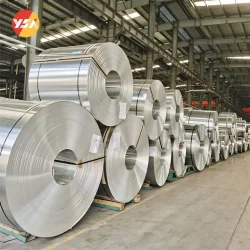1060 Aluminum
Chemical Properties
| Element | Composition (%) |
| Aluminum (Al) | ≥ 99.6% |
| Iron (Fe) | ≤ 0.35% |
| Silicon (Si) | ≤ 0.25% |
| Copper (Cu) | ≤ 0.05% |
| Manganese (Mn) | ≤ 0.03% |
| Magnesium (Mg) | ≤ 0.03% |
| Zinc (Zn) | ≤ 0.05% |
| Others | ≤ 0.15% |
Physical Properties
| Property | Value |
| Melting Point | 660 °C (1220 °F) |
| Density | 2.70 g/cm³ (0.097 lb/in³) |
| Thermal Conductivity | 237 W/(m·K) (138 BTU·in/(hr·ft²·°F)) |
| Electrical Conductivity | 62% IACS (International Annealed Copper Standard) |
| Modulus of Elasticity | 69 GPa (10,000 ksi) |
| Poisson’s Ratio | 0.33 |
| Reflectivity | 80-90% |
1060 Aluminum Foil Main Products



1060 aluminum foil finds applications in various industries, including food packaging, pharmaceutical packaging, electrical and electronic components, insulation.
When it comes to 1060 aluminum foil in the context of ventilation ducts, tape, food and pharmaceutical packaging, laminated insulation cotton, capacitor electrode foil, lithium battery foil, and sodium battery foil, it has the following applications:
- 1. Aluminum Foil Ducts
1060 aluminum foil is widely used in the manufacturing of flexible and semi-rigid ventilation ducts. The foil is laminated with other materials, such as polyester or polyethylene, to create a durable and lightweight ducting system for HVAC (heating, ventilation, and air conditioning) applications.
- 2. Aluminum Foil Tape
1060 aluminum foil is commonly used as the backing material in aluminum foil tapes. These tapes are used for sealing ductwork, joining insulation panels, and repairing HVAC systems. The foil provides a strong, heat-resistant, and moisture-resistant adhesive surface.
- 3. Aluminum Foil Food and Pharmaceutical Packaging
1060 aluminum foil is widely used in the packaging of food and pharmaceutical products. It is used for wrapping food items, such as chocolates, candies, snacks, and dairy products, providing a protective barrier against moisture, light, and oxygen.
- 4. Laminated Insulation Cotton with Aluminum Foil
1060 aluminum foil is used in the production of laminated insulation cotton. The foil is laminated with insulation materials, such as cotton or fiberglass, to enhance thermal insulation properties and provide protection against heat transfer and moisture.
- 5. Capacitor Electrode Foil
Due to its excellent electrical conductivity, 1060 aluminum foil is used as an electrode foil in capacitors. It helps in the conduction of electric current and energy storage in electronic and electrical applications.
- 6. Battery Foil
1060 aluminum foil is commonly used in the production of lithium-ion batteries. It serves as a protective layer and a current collector in the battery, ensuring efficient energy storage and stable battery performance. Sodium Battery Foil: 1060 aluminum foil is also applicable in sodium batteries. It is used as an electrode foil in sodium batteries, contributing to battery performance and stability.
1060 Alloy , 1050, 8011 Alloy- Similarities and Differences
1060, like 1050 and 8011 aluminum alloys, is a pure aluminum alloy and has good machinability and electrical conductivity. The differences are mainly in alloy composition, application areas, corrosion resistance and price.
- Common point:
1. Pure aluminum alloys: 1060 alloy, 1050 alloy and 8011 alloy are all pure aluminum alloys with a very high aluminum content of 99.6% (1060 alloy), 99.5% (1050 alloy) and 99% (8011 alloy) respectively.
2. Good machinability: These alloys all have good machinability and are easy to form, cut and weld.
3. electrical conductivity: 1060 alloy, 1050 alloy and 8011 alloy all have good electrical conductivity and are suitable for applications where electrical conductivity is required, such as capacitors, battery foils, etc.
- Differences:
1. Alloy Composition: The alloy compositions of 1060 alloy and 1050 alloy are very similar, but 1060 alloy contains a trace amount of copper element while 1050 alloy does not. While 8011 alloy contains small amounts of copper and iron elements.
2. Application areas: 1060 and 1050 alloys are commonly used in the manufacture of aluminum foils, capacitors, coolers and other applications. While 8011 alloy is mainly used in the manufacture of food packaging, pharmaceutical packaging and other applications that require high quality products.
3. Corrosion resistance: 8011 alloy has better corrosion resistance than 1060 and 1050 alloys, making it more common in food packaging and other applications that require corrosion protection.
4. Price: Due to the differences in formulations and applications of the different alloys, in general, 1060 and 1050 alloys are relatively less expensive, while 8011 alloy is relatively more expensive.
1060 Aluminum Foil Properties
Made from the 1060 aluminum alloy. 1060 Aluminum foil is a pure aluminum alloy with a minimum aluminum content of 99.6%.
- Purity
1060 aluminum foil is highly pure, making it suitable for applications that require a high level of electrical conductivity and thermal conductivity.
- Softness and Flexibility
Due to its soft and flexible nature, 1060 aluminum foil can be easily formed, folded, and shaped, making it ideal for various packaging and wrapping purposes.
- Heat Conductivity
1060 aluminum foil has excellent heat conductivity, making it widely used in heat exchangers, thermal insulation, and cooling applications.
- Corrosion Resistance
While 1060 aluminum foil has good resistance to atmospheric corrosion, it may not be suitable for highly corrosive environments or acidic conditions.
- Lightweight
1060 aluminum foil is lightweight, making it an ideal choice for applications where weight reduction is desired.

